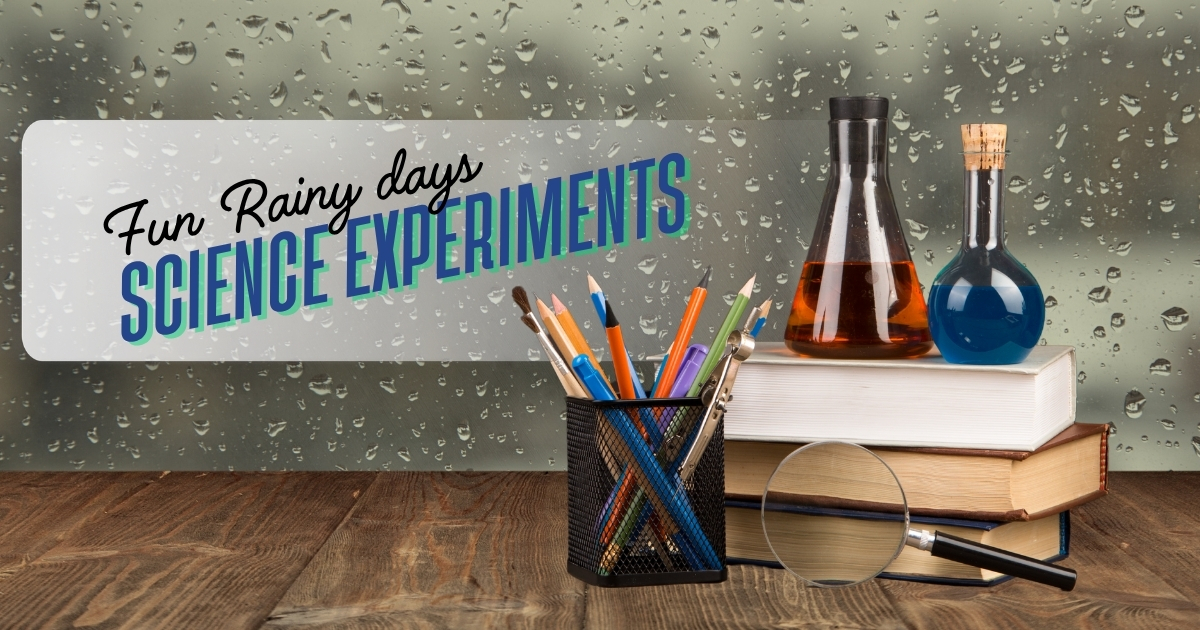Stuck indoors on a rainy day doesn’t mean the kids have to be bored! It’s the perfect opportunity to make learning fun with hands-on science experiments that everyone in the family can enjoy. These rainy day science activities are simple to set up, use items you likely already have at home, and encourage creativity, curiosity, and problem-solving.
Here are five exciting science experiments to try out that double as fun home science experiments for kids and easy science projects for families.
1. Create A DIY Volcano
Who doesn’t love a classic baking soda and vinegar volcano? This experiment combines chemistry and creativity to deliver an exciting eruption right in your kitchen.
What You’ll Need:
- Baking soda
- Vinegar
- Dish soap
- Red food coloring (optional)
- A plastic bottle or small container
- Paper, tape, and markers for decorating (optional)
Instructions:
- Place the plastic bottle on a tray or inside a large dish to contain the mess.
- Around the bottle, help your kids create a volcano shape using paper or clay. They can decorate it to make it look realistic.
- Fill the bottle halfway with vinegar. Add a few drops of red food coloring and a squirt of dish soap.
- Add two heaping spoons of baking soda to the bottle.
- Stand back and watch the “lava” bubble and foam out of the volcano!
This experiment is a fantastic way to explore chemical reactions. You can also play around with the quantities of ingredients for varied eruption effects!

2. DIY Rainbow In A Jar
This colorful experiment introduces kids to density and the properties of different liquids. The result? A dazzling, multi-colored rainbow layered inside a jar.
What You’ll Need:
- A tall, clear glass or jar
- Sugar
- Water
- Food coloring
- A spoon
Instructions:
- Pour about half a cup of water into a bowl. Add a different food coloring to several small bowls of water to make a variety of colors.
- Add increasing amounts of sugar to each bowl of water (e.g., one tablespoon in the first, two tablespoons in the second, three in the third). Stir until the sugar dissolves completely.
- Carefully pour the densest (most sugary) water into the jar first.
- Slowly add the next densest layer using a spoon to help pour the liquid gently down the side of the jar. Continue adding layers from most dense to least dense.
Kids will marvel as the vibrant rainbow appears! This project is great for teaching about density and how liquids can stack rather than mix under the right conditions.
3. Make Your Own Slime
Kids absolutely love slime, and making it from scratch is both entertaining and educational. This hands-on project explores the concept of polymers while delivering squishy, stretchy fun.
What You’ll Need:
- White glue
- Baking soda
- Contact lens solution (with boric acid)
- Optional add-ins like glitter, food coloring, or beads
Instructions:
- Pour about ½ cup of glue into a mixing bowl.
- Add a few drops of food coloring and mix well.
- Stir in 1 tablespoon of baking soda until fully dissolved.
- Slowly add 1 tablespoon of contact lens solution while stirring continuously. The slime will begin to form.
- Knead the mixture until it achieves a stretchy consistency. If it’s too sticky, add a little more contact lens solution.
Slime is a perfect way to combine fun with a lesson about how simple ingredients transform into something entirely new!
4. Experiment With Homemade Rain In A Jar
Rain doesn’t have to stay outside! This experiment brings the water cycle indoors, showing kids how rain forms in the atmosphere.
What You’ll Need:
- A glass jar
- Hot water
- Ice cubes
- A plate
Instructions:
- Pour a couple of inches of hot water into the jar.
- Cover the jar with a plate.
- Place a few ice cubes on top of the plate.
- Watch as the condensation begins to form, eventually creating “rain” inside the jar.
This simple yet effective experiment offers a visual explanation of evaporation, condensation, and precipitation. It’s an excellent activity for teaching weather-related science in an interactive way.
5. Build A Balloon-Powered Car
Transform ordinary balloons and household items into a fun introduction to physics! This hands-on project proves that learning about motion, propulsion, and engineering can be exciting.
What You’ll Need:
- A balloon
- A straw
- Tape
- A thin cardboard piece or paper plate
- Bottle caps or similar small items for wheels
- Skewers or pencils for axles
Instructions:
- Create a car body using cardboard or a paper plate. Attach skewers or pencils as axles.
- Tape bottle caps to the ends of each axle to serve as wheels.
- Tape a straw to the top of the car body. Slide a balloon onto one end of the straw and secure it with tape.
- Blow air into the balloon through the straw, hold the end closed, and then set your car down on a flat surface.
- Release the straw and watch your car zoom forward!
This creative project teaches kids about propulsion, motion, and energy transfer while encouraging them to experiment with different designs.
Tips For Making Rainy Day Science Fun
Rainy day science activities work best when the whole family gets involved. Here are some tips to help make the most of your time together:
- Get Messy: Don’t worry too much about the mess. Create a designated space with a tablecloth or tarp where kids can experiment freely.
- Ask Questions: Encourage curiosity by asking “why” and “how” questions throughout the activities. For example, “Why do you think the slime stretches like that?”
- Experiment Together: Test variations of the experiments to see what happens when you tweak the ingredients or amounts. It’s a great opportunity to teach kids that science often involves trial and error.
- Use a Science Notebook: Help your kids keep track of their observations, draw pictures, and write down results. A notebook makes them feel like real scientists while honing their writing and analytical skills.
Why Science Experiments Are Perfect for Rainy Days
Rainy days offer an excellent chance to shift focus from traditional lessons to hands-on discovery. Science experiments help children develop problem-solving skills, encourage creativity, and spark a deeper interest in everyday science.
Getting kids involved in experiments, especially ones where they can explore cause and effect, ignites their curiosity and helps them feel empowered. Plus, the family bonds created during these activities are priceless. They remind kids that learning doesn’t have to be boring or confined to textbooks. Instead, it can be as exciting as a slime-filled afternoon or a homemade volcanic eruption.
On top of that, science projects build critical thinking skills and foster an early appreciation for STEM subjects. Whether your child dreams of being an astronaut, engineer, or chemist, these enjoyable experiments are stepping stones toward bigger aspirations.
With these five activities and a few household items, you’re all set for a memorable and educational day! Whether it’s creating rainbows in jars or figuring out propulsion with balloon-powered cars, these experiments prove that science is fun, engaging, and accessible for all families—even on the rainiest of days.




